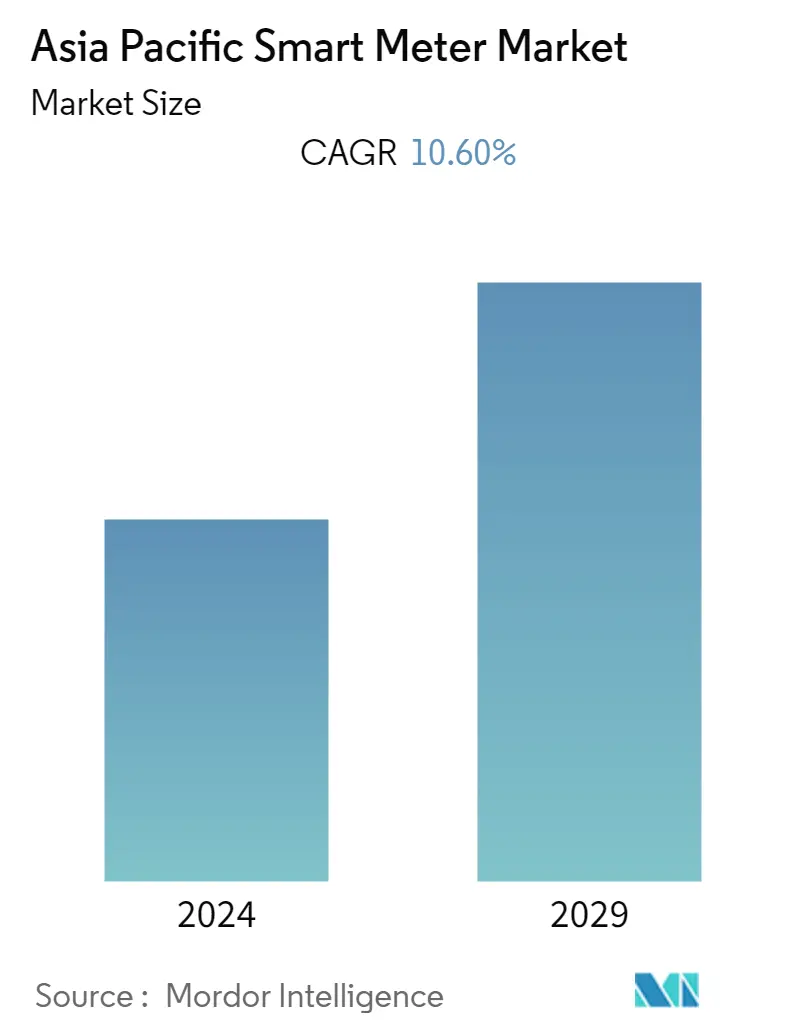Market Size of Asia Pacific Smart Meter Industry

| Study Period | 2019 - 2029 |
| Base Year For Estimation | 2023 |
| Forecast Data Period | 2024 - 2029 |
| Historical Data Period | 2019 - 2022 |
| CAGR | 10.60 % |
| Market Concentration | Medium |
Major Players
*Disclaimer: Major Players sorted in no particular order |
Need a report that reflects how COVID-19 has impacted this market and its growth?
APAC Smart Meter Market Analysis
The Asia-Pacific Smart Meter Market is estimated to register a CAGR of 10.6% for the forecast period (2022-2027). Smart grids are being implemented all over the world with the purpose of improving the efficiency of electricity networks. As a result, smart power meters, which are an important part of smart grids, are gaining in popularity around the Asia-Pacific region. Countries across the Asia-Pacific region are implementing emission control measures to fight pollution's negative impacts on the environment.
- The implementation of smart technologies such as analytics and cloud computing has increased significantly in the Asia-Pacific smart electric meter market. Several governments in the region have initiated smart city programs, which provide these businesses with a considerable growth opportunity. Furthermore, rising demand for remote monitoring and control of power grids would boost technological penetration in Asia-Pacific.
- Moreover, with smart city developments in China, Japan, India, and Australia, the need for smart water and smart gas meters in the region is predicted to rise in line with the UN's 2030 Agenda for Sustainable Development. In addition, pilot programs have been developed in Thailand and Malaysia, with more initiatives in Indonesia and the Philippines in the works. India has proven to be a difficult market for utility companies to convert to smart meters due to the country's low literacy rate.
- Electricity theft is higher than usual in India and Japan, although this can be reduced by using smart meters. In many underdeveloped economies, large-scale installations are prohibitively expensive due to low per capita electricity rates. Smart grid will boost smart meter market growth in the next years. Aside from that, both domestic and international smart metering providers are entering the market. As governments aim to solve energy sector concerns such as increases in energy demand and improve power quality, deployments of smart meters in China, Japan, Australia, and India are projected to increase in the Asia Pacific region.
- For Instance, Energy Efficiency Services Ltd's Smart Meter National Programme (SMNP) proposes that all conventional meters be replaced with smart meters by 2022, as recommended by Union Finance Minister in the 2020 budget (EESL). EDF, a French power company, and Energy Efficiency Services Ltd. installed roughly 1 lakh smart electric meters in India by 2020.
- China and South Korea are two especially isolated marketplaces with a significant number of local vendors serving their respective national utilities. Similarly, in the smart meter communications space, the countries have seen largely independent technology trajectories, with RF mesh, domestic PLC technologies, and cellular. In India's planned mass deployments, as well as in Australia's market-driven installations, cellular communications is projected to be a preferred alternative.
- Due to the implementation of lockdown in practically all major countries and the halting of non-essential operations, the COVID-19 pandemic has slowed the proliferation of smart meters. Due to a lack of focus on the development of the end user's industry, this had a negative impact on smart meters. Aside from that, manufacturing and supply chain delays have been seen, posing a barrier to smart meters. As people's movement was restricted, the manpower required for the initial arrangement of meters and installations was also hampered.
